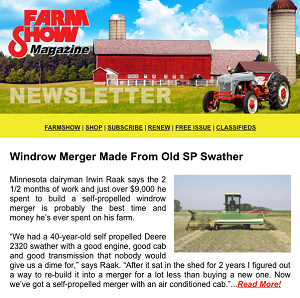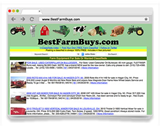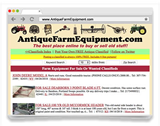Repurposed Spreader Boxes Save Money, Make Money
Don Bot and his son Chad are putting salvaged fertilizer spreader boxes to good use as heavy-duty fertilizer carts. Once mounted to a truck chassis, the multi-compartment fertilizer boxes with airflow distribution booms are often scrapped out. The used truck chassis find new uses as lime spreaders or large manure spreaders.
“We found a salvage dealer in Iowa with several airflow boxes for sale,” says Bot. “There was some corrosion and deterioration. However, there is a lot of stainless steel in the components, so they were all still in functioning condition.”
The Bots used 24-in. I-beams salvaged by a bridge contractor to build frames to match the box mounts. Wheels and axles came from salvage yard combines.
“I tend to over-engineer projects like this,” says Bot.
Over-engineering was a good thing, especially for the fertilizer cart intended to supply Bot’s homemade, 18-row, 22-in. row strip-tiller. Designed around a Deere chisel frame with an extended rear frame, the strip-tiller was heavy-duty enough for Bot to mount the distribution tower from the airflow system on it. The strip-tiller hooks onto its rear. The cart’s 4 bins hold nitrogen, phosphorous, potassium and sulfur. Two micronutrient boxes previously mounted inside the box were remounted to its rear. Two more micronutrient boxes from the salvage yard were also mounted to the cart’s rear. They hold zinc, copper, manganese and boron.
“We can control the individual flow of macro and micronutrients for variable rate fertilization,” says Bot.
An auger from the rear of the cart moves fertilizer to the distribution tower. From there, the nutrients are distributed to individual outlets at each strip.
The second cart was modified for use as a side-dress applicator. The airflow boom and distribution system were mounted on the front of the box. Drop hoses over every other row are equipped with Y-shaped tips that spread the fertilizer over the rows.
“Both fertilizer systems are hydraulically powered,” explains Bot. “The large tractor used on the strip-tiller can handle the load, but I wanted to use a smaller tractor with narrow wheels on the side-dress cart. We had to add a pto-powered hydraulic pump to power the air flow system.”
Bot credits the carts with giving him and his son increased flexibility and control of their inputs. To further control costs, they buy their fertilizer in bulk, storing it in a refurbished hog barn. They have also fabricated their own planter using a new toolbar with older planter units. They also added a used tender truck for bulk seed and fertilizer.
“We have roughly $100,000 in our field equipment and another $25,000 in tender, fertilizer loader and building maintenance,” says Bot.
His added software and controllers bring the cost of his strip-till system to about $150,000. He credits strip-till for increased yields and bulk fertilizer buys with reduced costs. He figures the yearly advantage of the system is about $93,000 on 600 acres of corn and soybeans, not to mention using the equipment to fertilize another 300 acres of wheat. In addition, the equipment is also used on his son Chad’s land.
Contact: FARM SHOW Followup, Don Bot, 2817 County Rd. 10, Cottonwood, Minn. 56229 (ph 507 828-3398; botfarms@mtvwireless.com).
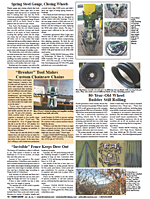
Click here to download page story appeared in.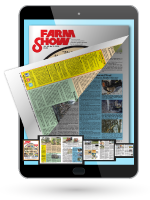
Click here to read entire issue
Repurposed Spreader Boxes Save Money Make Money FERTILIZER APPLICATION Don Bot and his son Chad are putting salvaged fertilizer spreader boxes to good use as heavy-duty fertilizer carts Once mounted to a truck chassis the multi-compartment fertilizer boxes with airflow distribution booms are often scrapped out The used truck chassis find new uses as lime spreaders or large manure spreaders “We found a salvage dealer in Iowa with several airflow boxes for sale ” says Bot “There was some corrosion and deterioration However there is a lot of stainless steel in the components so they were all still in functioning condition ” The Bots used 24-in I-beams salvaged by a bridge contractor to build frames to match the box mounts Wheels and axles came from salvage yard combines “I tend to over-engineer projects like this ” says Bot Over-engineering was a good thing especially for the fertilizer cart intended to supply Bot’s homemade 18-row 22-in row strip-tiller Designed around a Deere chisel frame with an extended rear frame the strip-tiller was heavy-duty enough for Bot to mount the distribution tower from the airflow system on it The strip-tiller hooks onto its rear The cart’s 4 bins hold nitrogen phosphorous potassium and sulfur Two micronutrient boxes previously mounted inside the box were remounted to its rear Two more micronutrient boxes from the salvage yard were also mounted to the cart’s rear They hold zinc copper manganese and boron “We can control the individual flow of macro and micronutrients for variable rate fertilization ” says Bot An auger from the rear of the cart moves fertilizer to the distribution tower From there the nutrients are distributed to individual outlets at each strip The second cart was modified for use as a side-dress applicator The airflow boom and distribution system were mounted on the front of the box Drop hoses over every other row are equipped with Y-shaped tips that spread the fertilizer over the rows “Both fertilizer systems are hydraulically powered ” explains Bot “The large tractor used on the strip-tiller can handle the load but I wanted to use a smaller tractor with narrow wheels on the side-dress cart We had to add a pto-powered hydraulic pump to power the air flow system ” Bot credits the carts with giving him and his son increased flexibility and control of their inputs To further control costs they buy their fertilizer in bulk storing it in a refurbished hog barn They have also fabricated their own planter using a new toolbar with older planter units They also added a used tender truck for bulk seed and fertilizer “We have roughly $100 000 in our field equipment and another $25 000 in tender fertilizer loader and building maintenance ” says Bot His added software and controllers bring the cost of his strip-till system to about $150 000 He credits strip-till for increased yields and bulk fertilizer buys with reduced costs He figures the yearly advantage of the system is about $93 000 on 600 acres of corn and soybeans not to mention using the equipment to fertilize another 300 acres of wheat In addition the equipment is also used on his son Chad’s land Contact: FARM SHOW Followup Don Bot 2817 County Rd 10 Cottonwood Minn 56229 ph 507 828-3398; botfarms@mtvwireless com
To read the rest of this story, download this issue below or click
here to register with your account number.






